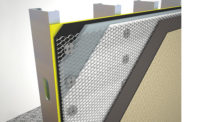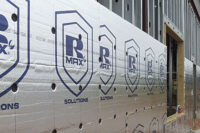Visit any construction site, in any city, in any country, throughout the world and ask the typical construction worker this question: How can you perform your job most efficiently? The answer in every language will always be the same: “Give me the proper tools and equipment for the job!”
The commercial and residential construction industry is continuously evolving. A renewed understanding of how the exterior building envelope functions has generated advancements in the building code that now, more often than not, require the use of air barriers and continuous insulation. Our industry has seen this first hand; however with any challenge, comes opportunity.
Whether you are a building material manufacturer, distributor, or subcontractor, you are faced with the challenge of competing in this ever-evolving industry. Perhaps the most significant controllable cost on any given project is labor cost. Smart builders know this and provide their teams with the tools and materials to get the job done, not just the right way, but also the most efficient way. Let’s take a look at a few tangible examples as they relate to the wall and ceiling industry, specifically for air barriers, continuous insulation, and lath attachment.
Air Barrier Systems
Air barriers as defined by the Air Barrier Association of America control the unintended movement of air into and out of a building enclosure. Mechanically attached building wrap air barrier systems are commonly used on residential, multi-family/mixed use, and commercial buildings alike. To attach building wrap over a wood substrate, it is important to use a capped fastener that will help seal the fastener penetration. Common staples are all too often used and the thousands of pinholes created on a single building pose an increased risk of air & moisture leakage. Furthermore, wind will often tear off exposed building wrap that is only tacked on with staples adding significant labor and material costs. When attaching building wrap over wood, cap-nail guns and slap-hammers should be utilized to reduce installed costs and help ensure proper air barrier performance.
For commercial applications with challenging substrates such as steel studs and exterior gypsum sheathing, a more robust fastener and tool is required. 1¾ or 2 inch diameter plastic washers, specifically designed for attaching building wrap, should be used with corrosion resistant self-drilling screws to attach the wrap while self-sealing the penetration against air leakage. To dramatically reduce labor costs, utilize screw fastening systems that use washer nose cups such as the Grip-Lok auto-feed fastening system. The nose cup holds the washer on the gun for fast, automated screw assembly and easy attachment to steel studs. This “third hand” enables the installer to move faster and safer across the wall when compared to ordinary drills that require two-handed operation (one hand on the drill while the other holds the screw and washer).
Continuous insulation is now often used on both wood and steel framed buildings to reduce thermal-bridging of the framing members. Though roofing nails, staples, or pan head screws might tack insulation on the wall, they do not provide an air tight seal, and should therefore be avoided if the rigid insulation is being installed as part of the air barrier system. For wood substrates with thin rigid continuous insulation (perhaps up to 1 inch thick) common cap nails can be utilized to tack up the insulation.
For thicker insulation or when the rigid insulation is being installed as part of the air barrier system, it is important to use corrosion resistant fasteners and larger diameter plastic washers specifically designed for attaching continuous insulation. (One-and-a-half or 2 diameter air sealing washers should be utilized to ensure the insulation doesn’t blow off or shift during the course of construction and furthermore that the fastener penetrations help self-seal against air and moisture penetration.)
Screw or Nail Assembly
Washers with dual prongs can be pre-spotted on the surface of the insulation enabling easy on-the-wall screw or nail assembly (no hand assembly of the screw/nail and washer is required further reducing labor costs). In fact, some pronged washers specifically designed for rigid insulation attachment, such as the 1¾ inch diameter Plasti-Grip ci prong washer, can even be shot-in with common nail guns for wood substrates. For steel stud substrates, auto-feed screw gun systems with bullseye nose adaptors, collated self-drilling screws, and pronged washers should be utilized to reduce installation and labor costs. Auto-feed screw gun systems can install the screws and insulation washers four times faster than ordinary drills when attaching to steel studs.
Lath attachment for stucco or stone veneer poses additional labor challenges and cost saving opportunities, especially when installed over continuous insulation. For wood and steel substrates alike, it is best practice to utilize a 1¼ inch diameter galvanized lath and plaster washer with an appropriate corrosion resistant nail or screw. The use of a large diameter washer designed for lath attachment helps disperse the load and prevents the lath from becoming uncoupled from the fastener.
Heavier cladding, like stucco or stone veneer, requires many fasteners when attaching through rigid continuous insulation, so the faster you can attach the lath, the faster you can start making money. The easiest way to rapidly attach lath is to use nail guns or auto-feed screw gun systems with magnetic nose adaptors. This magnetic “third-hand” retains the galvanized lath and plaster washer on the nose of the gun, which enables the lather to quickly and safely move across the wall, thereby reducing installed labor costs.
Simple solutions like auto-feed screw gun systems or nail guns with nose adaptors and purposely designed washer fasteners are a smart way to reduce labor costs while ensuring proper installation. Properly installed air barriers and continuous insulation are critical within a well-performing wall system. The ability to efficiently install these systems with the right tools and fasteners is critical to improve your labor costs and your bottom line.












